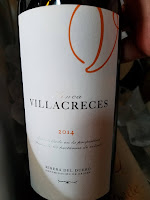 In 1835 at only 23 years old Manuel María González Ángel founded the precursor to Gonzalez Byass creating the Tío Pepe (Uncle Joe) sherry brand inspired by his uncle uncle, José Ángel. In fact the winery’s foundational solera is still inscribed with “Solera del Tío Pepe”. Nearly ten years into his operation Manuel united with his English Agent Robert Blake Byass to form González Byass as they shipped "exceptionally pale..." Tío Pepe wine to the United Kingdom. Together they built the company to be the leading exporter of sherry wines in Jerez. González Byass focused exclusively on sherry until the 1980's when they started incorporating wineries from other notable Spanish wine regions into the corporate umbrella. These included Bodegas Beronia - D.O.Ca. Rioja, Beronia Verdejo - D.O. Rueda, and Pazos de Lusco - D.O. Rías Baixas. And during the same period "the Byass family withdrew from the business and the winery passed into the hands of the direct descendants of Manuel María González". In time for spring, we were sent samples from each of these establishments that are suitable to the warming weather.
In 1835 at only 23 years old Manuel María González Ángel founded the precursor to Gonzalez Byass creating the Tío Pepe (Uncle Joe) sherry brand inspired by his uncle uncle, José Ángel. In fact the winery’s foundational solera is still inscribed with “Solera del Tío Pepe”. Nearly ten years into his operation Manuel united with his English Agent Robert Blake Byass to form González Byass as they shipped "exceptionally pale..." Tío Pepe wine to the United Kingdom. Together they built the company to be the leading exporter of sherry wines in Jerez. González Byass focused exclusively on sherry until the 1980's when they started incorporating wineries from other notable Spanish wine regions into the corporate umbrella. These included Bodegas Beronia - D.O.Ca. Rioja, Beronia Verdejo - D.O. Rueda, and Pazos de Lusco - D.O. Rías Baixas. And during the same period "the Byass family withdrew from the business and the winery passed into the hands of the direct descendants of Manuel María González". In time for spring, we were sent samples from each of these establishments that are suitable to the warming weather. Tio Pepe ($19.99)
Tio Pepe ($19.99)González Byass owns 800 hectares in vineyards in Jerez Superior where the hand picked Palomino grapes are gently pressed without crushing the stems, seeds, or skins. The resulting must is called "yema" which is fermented and fortified to 15.5% then enters the Tio Pepe solera system where it is aged for four years in American oak. During this aging period the wine undergoes biological aging under a layer of yeast called "flor". This gives Tio Pepe its unique pungent aromas that blend with the almond notes characteristic of the Palomino grape. For some dry sherry is an acquired taste so the colder it's served, the less prevalent these aromas. Also consider the cocktail route using dry vermouth and orange bitters.
 Beronia Rosé 2017 ($12.99)
Beronia Rosé 2017 ($12.99)Rioja is situated in the Ebro Valley hemmed to the north by the Cantabria mountain range and to the south by the Demanda range and creating an enclave for the eventual production of quality wines. Yet in ancient times it was inhabited by a Celtic tribe called Berones who called the area Beronia. In modern times (1973) as the region now know as Rioja became the preeminent Spanish wine producing region, members of a gastronomic society founded Bodegas Beronia -- which was eventually incorporated into the González Byass portfolio. The winery is specifically located in Rioja Alta -- the western most of the three major Rioja sub-regions -- and it's high elevation and Atlantic climate assists in the development of acidity, color and moderate alcohol levels. Like most of Rioja, the Tempranillo grape reigns supreme and this rosé is 100% gently pressed Tempranillo. It is very light, all strawberries with a long creamy and acidic tail.
Beronia Rueda 2017 ($12.99)
Beronia ventured into Rueda, Spain's first D.O. located in continental conditions northwest of Madrid. Verdejo is that region's signature grape and Beronia creates a unique wine y combining two harvests from two vineyards (Finca El Torrejón and Finca La Perdiz). In both vineyards the first harvest "produces a fresher wine with more herbaceous aromas, with touches of boxwood, grass and fennel" whereas the second starts a few days later and "collects riper grapes that offer up stone fruit and other, more exotic fruits". The result is a fantastic wine, with racy minerals combining with herbs and citrus and stone fruit flavors. What a value as well.
 Pazo de Lusco Albarino 2016 ($24.99)
Pazo de Lusco Albarino 2016 ($24.99)Whereas other Spanish wine regions are noted for their dry desert-like conditions, the northwestern Spanish region of Galicia received 71 inches of rainfall each year providing a lush landscape and moisture rich environment for the white Albariño grape. The D.O. Rías Baixas denomination is divided into five sub-regions with the southernmost Condado do Tea (The County of Tea) named after the river Tea which separates the border with Portugal. The five hectare Pazos de Lusco estate is located here and the Albariño grapes are hand harvested, fermented with its natural yeasts, and gently pressed. The result is a wine with a strong floral and tropical aroma, citrus and minerals, and uplifted with powerful acidity. Wow.











